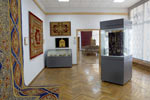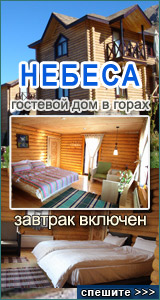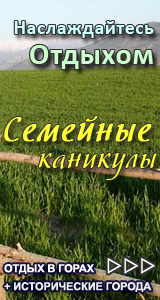In 1927, the first exhibition of best works of Uzbek masters was conducted. Subsequently it has grown to a permanent one and became known as "National Exhibition of Uzbekistan".
In the following years, the exhibition was enriched with different works of art. Along with it, other samples like hand-made embroidery, jewellery, carpets and other works of applied art that were made in past centuries were bought and demonstrated at the exhibition. Namely these collected samples of applied art were demonstrated in the Museum of Handicraft Art which was opened on
7 of July 1937 in Tashkent.
In 1960, the museum was renamed to "Permanent Exhibition of Applied Art of Uzbekistan"
In 1997, the museum was handed over to the Ministry of Cultural Affairs of the Republic of Uzbekistan and received a status of the "State Museum of Applied Art".
At present time, priceless samples of applied art created by golden hands of masters from the first half of XIX century to the present time are collected in depository of the museum.

Facade of museum 1942 year
|
|

Facade of museum 2007 year
|
Works of applied art that are kept in depository of the museum could be divided into
3 groups.
Firstly, these are works of applied art that were created on the basis of ancient traditions and are related to different schools which reflect originality of individual region. Secondly, these are more enriched by ornamental patterns works that were developed since the second half of XX century and which were made using traditional methods of folk masters.
And the third group consists of works of applied art that meet requirements of contemporary art and which are decorated by rare multicoloured ornamental patterns.
Collected in the depository of museum works of art are kept in collections that are divided into
20 titles and demonstrated in expositions by its kind.
Uzbek people are known to the whole world for its ancient applied art. The art of making jewellery is considered as one of the most ancient. Rare samples of folk art remained in carving, coining, jewellery, ceramics, carpet weaving, sericulture, embroidery and in other dozen of kinds of applied art. At present time these priceless samples of our heritage are kept in our museums.
President of the Republic of Uzbekistan I.A. Karimov justly noticed: "We recognise the nation not by the name, we recognise the nation by the culture, spirituality, by taking a deep look at the roots of its history.
Truly, priceless monuments of our material and spiritual culture, which are kept in depository of our museums, are rare witnesses of our history. During years of independence, special attention was dedicated to a significant improvement of museum's functions. A graphic evidence of it is adoption in
1994 and 1998 of two decrees of the Ministry Cabinet on measures of improvement of museum's functions, creation of fund "Uzbekmuseum" and construction of the following museums in Tashkent: "History of Uzbekistan", "History of Timurid's epoch", "Monument to the victims of repression" and construction of archaeological museum in Termez. In the decree of the President of the Republic of Uzbekistan from
12 of January, 1998 "On improvement and perfection of museum's functions" pointed out: "Even greater to perfect museums that existed on the territory of Uzbekistan from the earliest times. Study, enrich, save, show to the whole world and propagandise rare and priceless exhibits that are kept in depository of our museums that are showing the steps of our independence and rich history of our nation. Use them in order to increase awareness, dedication to our motherland and independence, national self-consciousness and pride.
Rarest monuments of applied art that are inseparable part of national culture are kept in State Museum of applied art.
More than 50 kinds of applied art are demonstrated in expositions of the museum.
As is well known, peculiar centres of national artistic handicraft art have been shaping on the territory of Uzbekistan for centuries. Each region is different from the other by its art of artistic decoration. In particular, Chust is well know for its knifes and tyubeteikas; Rishtan for its azure ceramics, Margilan for its iridescent satin, Bukhara for its gold embroidery
You receive a real pleasure from miracles created by man and from originality of works of art while viewing the halls of the museum.
The museum doesn't have capability to demonstrate more than 7000 rare works of applied art that are kept in depository of the museum. This integrated catalogue has been prepared with the purpose to familiarise the public with our rich cultural heritage and to shape pride, especially among young people for our great cultural heritage. This catalogue has been prepared for you, connoisseurs of art. This is why we are hoping that you will express you opinions about this catalogue.
|
|
| |

The museum doesn't have capability
to demonstrate more than 7000
rare works of applied art that are
kept in depository of the museum |
|
| |
| |

Tashkent teachers
Toshpulat Arslonkulov
|
|
| |
| |

You receive a real pleasure from
miracles created by man and from originality of works of art while
viewing the halls of the museum |
|
| |
| |

Exposition of the central hall,
northern side. The furnace and
Ceramic products
|
|
| |
| |

More than 50 kinds of applied
art are demonstrated in expositions
of the museum |
|
| |
| |

Facade of western side
Museum. 1961 |
|
| |
|








































